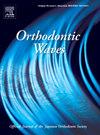A skeletal Class III facial asymmetry case with a canted occlusal plane treated by LeFort I with unilateral horseshoe osteotomy
IF 0.5
Q4 DENTISTRY, ORAL SURGERY & MEDICINE
引用次数: 0
Abstract
ABSTRACT To treat facial asymmetry with severe inclination of the frontal occlusal plane, unilateral maxillary impaction in the molar region must be performed to reposition the maxilla. We herein report the successful surgical-orthodontic treatment of a patient with facial asymmetry and significant canted occlusal plane by LeFort I combined with unilateral horseshoe osteotomy and mandibular bilateral intraoral vertical ramus osteotomy (IVRO). A 20-year-old male patient had a chief complaint of mandibular protrusion and mandibular dental crowding. The total active treatment period was 31 months. After postsurgical orthodontic treatment, the right side of the maxilla was impacted by 4.0 mm, while the left side was maintained vertically. The facial asymmetry and canted occlusal plane had mostly improved and satisfactory occlusion, and a straight-type profile had been obtained. In addition, the condylar path length was increased during maximum reciprocal jaw movement, and the incisal path became stable during lateral excursion. Acceptable occlusion and a satisfactory facial profile were maintained after the two-year retention period. Our results suggest that the combination of LeFort I with unilateral horseshoe osteotomy is a useful technique for achieving reliable, superior repositioning of maxillae with a severe cant.LeFort I单侧马蹄截骨术治疗III类面部骨不对称伴咬合平面倾斜病例
为了治疗面部不对称伴额颌平面严重倾斜的患者,必须在磨牙区进行单侧上颌嵌塞以复位上颌。我们在此报告LeFort I联合单侧马蹄截骨和下颌双侧口内垂直支截骨术(IVRO)成功治疗了一例面部不对称和咬合平面明显倾斜的患者。男性,20岁,主诉为下颌骨突出和下颌牙群拥挤。总有效治疗期31个月。术后正畸治疗后,右侧上颌骨阻生4.0 mm,左侧上颌骨保持垂直。面部不对称和倾斜的咬合平面大多改善和满意的咬合,并获得了直型轮廓。此外,在最大的下颌运动时,髁突路径长度增加,切牙路径在侧向运动时变得稳定。在两年的保留期后,可接受的咬合和令人满意的面部轮廓保持不变。我们的研究结果表明,LeFort I联合单侧马蹄截骨术是一种有效的技术,可以实现可靠、优越的上颌复位。
本文章由计算机程序翻译,如有差异,请以英文原文为准。
求助全文
约1分钟内获得全文
求助全文
来源期刊

Orthodontic Waves
DENTISTRY, ORAL SURGERY & MEDICINE-
CiteScore
0.40
自引率
0.00%
发文量
0
期刊介绍:
Orthodontic Waves is the official publication of the Japanese Orthodontic Society. The aim of this journal is to foster the advancement of orthodontic research and practice. The journal seeks to publish original articles (i) definitive reports of wide interest to the orthodontic community, (ii) Case Reports and (iii) Short Communications. Research papers stand on the scientific basis of orthodontics. Clinical topics covered include all techniques and approaches to treatment planning. All submissions are subject to peer review.
 求助内容:
求助内容: 应助结果提醒方式:
应助结果提醒方式:


